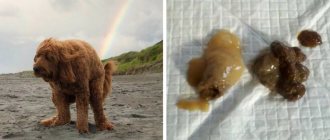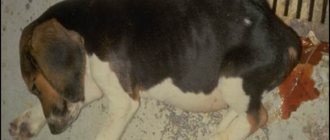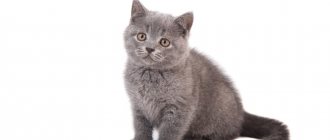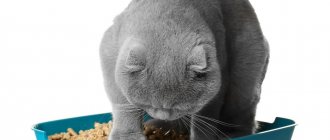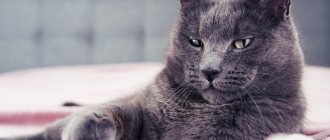If your furry pet has no health problems, his stool does not contain any additional inclusions. In appearance it is dense and formed. Mucus found in a cat's feces, blood discharge or diarrhea signal to the owner that problems have arisen in the animal's body, often of a serious nature. After independently studying the symptoms, it is recommended to seek help from a veterinary clinic or hospital, take the prescribed tests, and then the doctor will be able to prescribe effective treatment for the disease.
The main causes of mucus
It's hard not to notice the deviation. Mucus in appearance resembles translucent or white viscous substances in feces. There may be a small amount of them, but it also happens that the discharge completely covers the cat feces. In each case, this is a signal to quickly contact a specialist, since pathological changes occur in the cat’s body. The appearance of mucus is caused by the following reasons:
- the appearance of worms;
- bacterial infections and diseases;
- binge eating;
- functional failure of the digestive system;
- fatty diet;
- stressful situations;
- allergic reactions of the body;
- wool in the gastrointestinal tract;
- reaction to medications;
- weakened immunity;
- a sharp change in the food menu;
- intoxication;
- clogged intestines.
A fatty diet in an animal can lead to such a disturbance in the appearance of feces.
All these various reasons contribute to a malfunction of the body, thereby causing mucus and scarlet blood in the cat’s stool. A person cannot influence their occurrence and it is almost impossible to independently determine why a kitten has foreign discharge and transparent ichor in its stool. However, with such impurities and additional symptoms, it is clearly noticeable that the animal is sick.
This is interesting: How many bones does a cat have?
Diseases in the anus in animals
Let's talk about the area under the animal's tail, namely the anus and everything that is next to it, in particular we'll talk about the paraanal glands . Very often, veterinarians have to deal with diseases of domestic animals that develop in the anal area and bring enormous suffering to dogs and cats.
The conversation will be about that place on the body of our pets, which owners rarely look closely at, perhaps out of a feeling of disgust.
So, I propose to talk about the area under the animal’s tail, namely the anus and everything that is next to it, in particular let’s talk about the PARANANAL GLANDS.
Often, very often, I have to deal with diseases that develop in this delicate area and bring enormous suffering to our pets (dogs and cats). But you can prevent suffering if you know that it is simply necessary to periodically check the condition of the anal glands, clean them if necessary, and prevent them from becoming clogged and developing inflammation.
I have been working as a veterinarian since 1986 (that is, 25 years), and I have been a pet lover my entire adult life (that is, about 40 years). I remember that in those books on dog breeding that I read as a child, there were pictures indicating the location of the paraanal (peri-anal, anal) glands and the rules for caring for them. And this procedure was indicated as a mandatory procedure for caring for a dog (literature about cats had not yet been published in those days, and they practically did not engage in cat breeding). I searched about this in modern literature - empty, they don’t write about it in popular literature.
Let my colleagues forgive me, the conversation will go to the owners
Source
Serious illnesses requiring immediate treatment
Often, a cat develops mucus in its feces due to serious illnesses that can be fatal. The most common cause of impurities in stool is infestation with parasites. In the absence of treatment and the rapid proliferation of worms, all internal organs are affected, helminths penetrate into the blood, damaging the mucous membranes, walls of the stomach or intestines. The disruption of the digestive process results in the appearance of mucus and blood particles.
Intolerance to lactose contained in milk is another reason for the appearance of impurities in stool. Regular consumption of dairy products will result in a malfunction of the digestive system, severe irritation and even the development of irreversible processes in the body.
If the owners notice white feces with mucus in their cat, they should not hesitate - such a sign often indicates damage to the genitourinary system. Delay in treatment will result in serious organ failure and the development of serious diseases that threaten the pet’s life.
Visit to the veterinarian
Since the presence of mucus in a cat's stool can be caused by many reasons, the true diagnosis can only be determined by a veterinarian. Therefore, a visit to the doctor should not be delayed, otherwise the disease may reach a severe stage.
Having determined why the stool comes out with mucus, the specialist will prescribe therapy appropriate to the identified disease. The cat will be prescribed special medications, and the owner will be given recommendations for treatment and care. All this must be done in strict order.
If the cat's owner is sure that the cause of mucus in the feces lies not in a serious illness, but in a banal disorder due to inappropriate food or the consequences of deworming, you can try to help the pet at home:
- Give the cat a therapeutic fast (fasting for 12 or 24 hours). In this case, it is necessary to drink your pet with clean water.
- If the animal refuses to drink, you will have to force it to do so. You will need to pour a small amount of water into the cat's mouth to avoid dehydration.
- If the cat has overeaten or is not seriously poisoned, give it activated charcoal every 6 hours.
- To normalize the intestinal microflora in case of food poisoning or mild disorder, you can give a children's dose of Smecta. This drug is one of the few human medications approved for use by animals (as is activated charcoal).
- As an astringent for minor causes of diarrhea, cats are given a decoction of oak bark to drink (after 1-2 times the diarrhea should stop).
If the cat’s condition has not improved within 24 hours, the feces are still slimy, and the accompanying symptoms persist or increase, you cannot continue independent treatment. In this case, the pet must be urgently taken to a veterinarian, who will examine the patient, conduct diagnostics and determine how to treat the animal.
How to treat kittens
Small furry cats are treated slightly differently than adult cats.
Firstly, there should be no self-medication here. The owners do not have time to find out the cause of mucus in the kitten’s feces, because in a small body any disease develops faster and stronger than in an adult. The baby needs to be helped as soon as possible, and only a veterinarian can do this efficiently.
First aid
When a cat has diarrhea with mucus, dehydration often occurs, especially if it is accompanied by vomiting. Do not attempt to treat your animal at home. Digestive upset will not go away on its own, you should consult a doctor.
If a trip to the clinic is not possible at the moment, then provide first aid to the cat.:
- create calm conditions at home;
- do not restrict the cat’s access to the litter box;
- after each act of defecation, wipe the anus area with special wet wipes for animals;
- do not feed the cat;
- do not restrict access to water.
© shutterstock
If severe dehydration occurs, administer sodium chloride solution subcutaneously to the cat. If you have medical skills, after consultation with a veterinarian, you can do IVs.
Causes of blood in cat stool
Blood can only enter natural products from the gastrointestinal tract. A more precise location of the damage can be determined by paying attention to its color.
Bright scarlet color of blood
- The reason for the appearance of this color of blood in a cat's stool may be a foreign object that the animal has swallowed and which is trying to come out along with the feces. Kittens often play with various sharp objects or pebbles, which can cause serious injury to the gastrointestinal tract. The pet becomes restless at this time and may develop a fever.
- Incorrectly selected food can also injure a cat’s gastrointestinal tract. An adult animal can scratch its stomach with a piece of bone, and a small kitten can scratch it with dry food, which it chewed poorly.
- Constipation is another reason for the appearance of scarlet blood in a cat's stool. The feces harden, and the act of defecation causes pain for the pet. The anus is injured during the process of emptying, and blood appears in the stool. If your cat is constipated, you should give your cat a laxative and make sure she always has a bowl of fresh water available. In case of prolonged constipation, the animal must be taken to the veterinarian.
Helminthiasis is the cause of blood
Brown blood indicates that helminths have settled in the cat’s body. Most often, this can happen to an animal picked up on the street or to a pet that comes into contact with stray cats.
- With helminthiasis, a cat may experience decreased activity, lethargy, diarrhea, vomiting, and nausea. At the same time, the pet does not refuse food.
- In this case, the animal should be treated with two courses of anthelmintic drugs.
- It is recommended to give anthelmintic drugs to domestic cats twice a year as a preventive measure.
The main thing is to choose the right drug and follow the dosage.
If such symptoms are observed in a cat that definitely cannot be infected with helminths, then you need to contact a veterinarian. Exacerbation of pancreatitis.
Exacerbation of pancreatitis can also cause similar symptoms. In this case, the cat will need to be put on a strict diet and remember that the gastrointestinal tract is its weak point. The diet for such an animal must be prepared more carefully and competently.
Allergic reactions.
One of the reasons for the appearance of blood in a cat's stool may be an allergy to food. Manufacturers often add corn flour, natural flavors and various stabilizers to dry food. Therefore, you can try changing the food, and if there are changes, then it’s better to forget about the old food. Another option is to switch to completely natural foods.
Colitis
Blood and mucus in a cat's stool most often indicate a disease such as colitis.
- During its exacerbation, the animal alternates with constipation and diarrhea, and pain appears in the lower abdomen.
- Feces change color and smell.
- In advanced cases, the pet's metabolism is disrupted and it loses weight.
- Colitis can be triggered by stress, infections, allergies, poor diet, or worms.
Ignoring this problem jeopardizes not only the cat’s health, but also its life. Therefore, you need to consult a doctor who will need to have your pet’s stool tested. Only a veterinarian can prescribe the correct treatment and stabilize the animal’s condition.
Neoplasms and tumors.
Another reason for the appearance of blood in the stool is neoplasm and tumor. This version can only be refuted or confirmed with the help of ultrasound and biopsy, which is done under anesthesia. The course of treatment for the cat will be prescribed by the doctor.
The cat has black diarrhea
The usual color of cat feces is brown or light brown. But liquid black stool called “melena” signals a problem in the body.
Dark stool in a cat has its own reasons:
- iron supplements have been added to food;
- The pet's menu contains a lot of raw meat or blood meal.
But black diarrhea in a cat without the inclusion of iron supplements in the diet should warn the owner of the danger. If, along with stool upset, the animal refuses to eat, vomits, or has an elevated body temperature, consult a doctor immediately!
Red-black diarrhea indicates bleeding in the gastrointestinal tract.
How to recognize?
The manifestation of the following symptoms indicates the following diseases:
- If a cat poops mucus, this is a consequence of exceeding the dose of vitamins.
- Bloating and loose stools in your pet indicate intolerance to certain foods in the diet.
- Lumps of mucus in diarrhea, vomiting, and weight loss indicate inflammatory processes in the gastrointestinal tract.
- Loose stools with white inclusions, weakness, lethargy, nausea, discharge from the eyeballs and nose indicate that a viral infection is spreading throughout the body.
- Modified feces with mucus, restlessness of the pet, pain in the abdominal area are considered the main symptoms of colitis or enteritis.
- Feces acquire a pungent, stinking odor, and there is mucus and blood present—signaling inflammation or oncology.
- Liquid stool consistency with dark streaks, vomiting, and rapid loss of body weight indicate the presence of worms in the body.
- If the feces have acquired green or yellow shades, increased appetite, flatulence, bloating - reasons to check the condition of the cat's pancreas.
Only if your pet takes antihelminthic medications can you not worry about mucus in the stool. This sign is not considered a pathology and may persist for the first few days after the procedure. The cat goes to the toilet this way simply because its body is cleaning itself.
This is interesting: Why don't cats look in the mirror?
Why does mucus appear in stool?
It is difficult not to see that a cat has mucus in its stool. Usually this phenomenon is immediately noticeable and looks like transparent or whitish impurities in the general stool. Sometimes there are not many of them, but sometimes the feces are completely covered with mucous secretions. In any case, this is an anomaly that may indicate pathologies that have arisen in the animal’s body.
The appearance of mucus in stool can be caused by a number of reasons:
- the presence of worms;
- viral or bacterial diseases;
- intolerance to certain foods;
- excessive overfeeding;
- metabolic failures;
- intestinal obstruction;
- stressful state (when changing place of residence or owners);
- food that is too fatty;
- incorrectly formulated diet or eating disorders;
- inflammatory processes in the digestive system;
- consequences of poisoning with bad food, chemicals or poisons;
- abrupt change of menu;
- allergy;
- decreased body resistance to diseases;
- reaction to certain drugs;
- wool in the stomach.
The reasons are so varied that it is almost impossible for an ignorant person to independently determine why a cat poops feces with mucus. But the fact that not everything is all right with the pet is obvious. In addition to the foreign impurities themselves, additional symptoms help to understand this.
Associated signs of an unhealthy pet
The following symptoms, which can appear due to a number of diseases, should be a reason to worry about your cat:
- diarrhea with mucus may indicate an overdose of vitamins;
- flatulence and diarrhea often indicate food intolerance that has arisen, which will simply need to be excluded from the diet;
- lumps of mucus in liquid feces, nausea, weight loss, sometimes vomiting, and at the same time the cat often licks itself - chronic inflammation in any part of the digestive tract is possible;
- the feces have become greasy, bright yellow or greenish, vomiting, flatulence, nausea have appeared, appetite has noticeably increased - it’s time to check your pet’s pancreas;
- the cat has blood and mucus in its stool, the animal feels sick and vomits, it loses its appetite, the pet experiences a sudden weight loss - this is due to viruses or bacteria;
- the stool is liquid, dark, tarry, with mucus, the pet vomits, weight loss is observed - a clear sign of the presence of worms;
- severe diarrhea with clear or white discharge, vomiting, weakness, lethargy, sometimes discharge from the cat’s nose and eyes is visible or there are ulcerations on the mucous membranes - viral diseases are evident;
- the stool is modified, contains mucus, the pet is worried, does not make contact, and especially does not allow the stomach to be felt due to pain - these are symptoms of colitis, enterocolitis or enteritis;
- the feces have a sharp disgusting smell, there are admixtures of mucus and blood - very severe inflammation or cancer of the digestive organs is possible.
Perhaps the only case when you don’t have to worry about mucus in the feces is in the first time after your cat takes anthelmintic drugs (i.e. after deworming). In the first days after the end of such a treatment and prophylactic course, mucus impurities in the feces are observed very often and do not indicate serious pathologies in the cat’s body. The absence of diseases is confirmed by the good general health of the animal (normal appetite, cheerful mood, etc.). No treatment is required here; everything goes away on its own within a few days.
The cat has yellow diarrhea
global $ads_google; //data-ad-slot=”2475549904″ $ads_google = empty($ads_google) ? false : true; ?> if ($ads_google == false) {?>
$ads_google = true; ?> } ?>
Yellow diarrhea in a cat without signs of orange is considered normal, since bilirubin in bile is processed into brown stercobilin, and with loose stools, bilirubin may not be completely processed. But bright yellow or yellow-orange stools indicate jaundice or poor absorption of foods. Having analyzed the cat’s menu of the last few days, and noticing that there was a lot of milk, raw seafood, liver, and fatty meat, they urgently change the pet’s diet. If a half-starvation diet does not produce results, the cat is shown to a specialist.
How to treat
If the cause of yellow diarrhea in a cat is overfeeding or a reaction to new food, then you can do home treatment. But this can only be done if the cat’s condition does not cause concern. Home treatment consists of supervision - the cat’s condition must be kept under control, and the younger the pet, the more dangerous loose stools are. Dehydration can kill a kitten very quickly. Access to clean boiled water is required.
Since bilirubin is an aggressive substance, after each bowel movement you need to wash the dirty area around the anus with warm water and soap.
If yellow diarrhea is the result of overfeeding, then the cat is offered a tablespoon of pumpkin puree 2-3 times a day. You can use ready-made baby puree.
Basic tests as a diagnostic method
In order to diagnose the disease, the veterinarian may be interested in:
- The cat's attempts to rub its butt on the carpets. This behavior indicates an existing problem with the anal sinuses.
- Injuries, blows, bites in this area. May cause great discomfort for the animal.
- Detailed description of your pet's diet.
- Swallowed objects, ingestion of spoiled food.
If the doctor needs to clarify something, the animal may be sent for an x-ray.
Upon receipt of all the answers of interest, the veterinarian immediately makes a diagnosis or prescribes additional procedures. So, he can send the cat for feces, urine, blood, and examination of the rectum by swallowing a probe under anesthesia. By analyzing the profile of chemical elements in the bloodstream, it is possible to understand what is happening in the body. Colonoscopy and x-rays of organs are performed as prescribed by the doctor. As a result of receiving answers, effective and efficient treatment of the disease is selected.
When to contact a veterinarian
You need to contact a specialist if:
- The pet began to go to the toilet much more often.
- When attempting to defecate, the animal becomes very tense.
- Blood more than one small speck in size was observed in the stool more than once.
Often, the presence of blood can be just one of the signs of a cat disease. If she also has other symptoms, then you should rush to the doctor.
- Diarrhea.
- Vomit.
- Frequent urination.
- Fast weight loss.
- Lack of appetite.
- Increased thirst.
- Apathy.
The doctor will conduct a diagnosis and identify the cause of all these symptoms.
Diagnosis of the causes of bleeding in cats
First of all, the doctor may ask a series of questions to understand why your cat has blood or mucus in her stool.
- Does your pet run its butt on carpets? (this animal behavior most often indicates problems with the anal sinuses).
- Is the cat's anal area injured by a fall, blow, or bite from another animal?
- Does the cat eat natural food? If so, which one?
- Has the animal's diet changed recently?
- Could your pet have swallowed a bone, inedible object, or eaten spoiled food?
Having heard the answers to all the questions, the doctor can immediately understand the cause of the disease, or prescribe additional diagnostic procedures.
- Stool analysis.
- Analysis of urine.
- Detailed blood test.
- Rectal examination.
- Analysis of the profile of chemicals in the blood.
- Colonoscopy.
- Ultrasound or x-ray of the abdominal organs.
Depending on the test results, the doctor will prescribe treatment.
The cat has diarrhea and vomiting
With a combination of symptoms such as diarrhea and vomiting in a cat, most likely the body is struggling with various negative influences of the external environment. Allergenic, irritating, poor quality food is cited as the cause. Another reason may be tumors, bacteria and traces of their activity, pancreatitis, kidney disease, abnormalities in the thyroid gland, intestinal obstruction.
If a cat is vomiting, it is likely that sunstroke or heatstroke could be added to everything. A pet vomits with diarrhea, most often as a result of feeding food from the owner’s table, which causes stool upset.
When cats vomit white foam during prolonged diarrhea, this is an alarming symptom - it can be fatal enteritis.
What to do if you have diarrhea with vomiting
global $ads_google; //data-ad-slot=”2475549904″ $ads_google = empty($ads_google) ? false : true; ?> if ($ads_google == false) {?>
$ads_google = true; ?> } ?>
In cases where cats have diarrhea with vomiting, the pets should immediately receive first aid. Immediately wash all the cat's dishes, and change the water to clean and fresh. The cat should not be fed for 24-48 hours. During such a therapeutic hunger strike, you can buy canned food at the pet store for animals with gastrointestinal diseases. Specialized food will not irritate the walls of the stomach and intestines, and the special composition of canned food helps eliminate toxins and form feces. You can add probiotics to your food.
Your veterinarian may recommend a number of medications that should be given to your cat during loose stools and vomiting. If the measures taken do not give a positive result, the animal must be seriously examined. Vomiting with blood requires special attention from a doctor.

